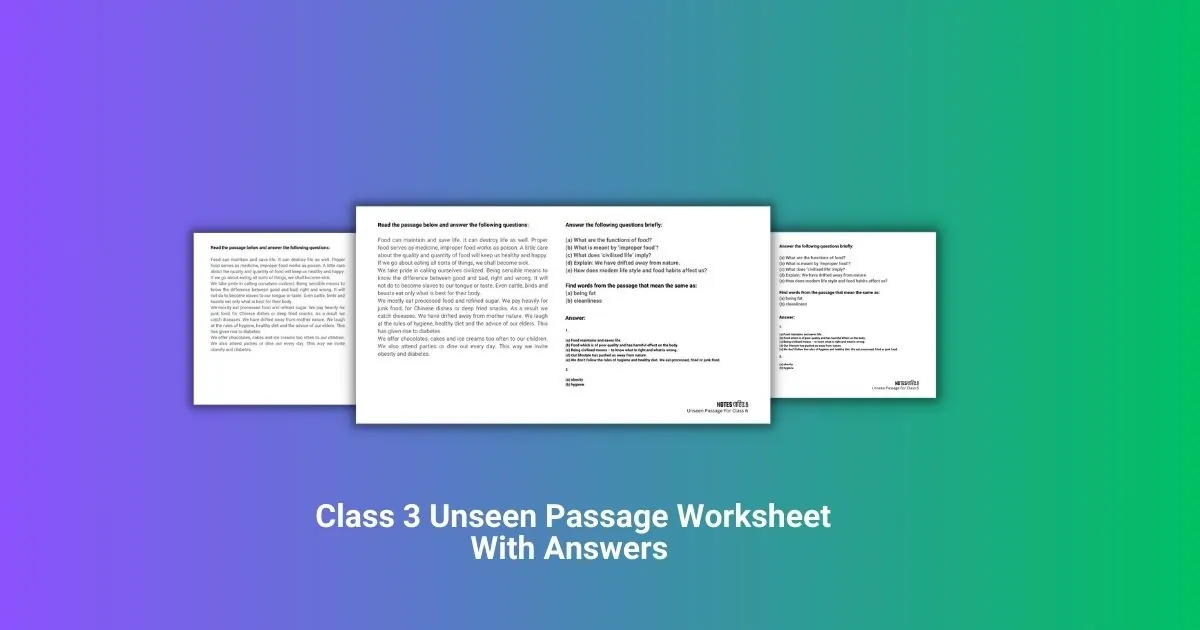Class 3 Unseen Passage help student to learn vocabularies and understand how to answer the questions. Here we have mentioned best 30 unseen passages in English so that you can use it to teach your students how to read comprehension writings.
Before you jump to Unseen Passages, you must know how to solve them. You should follow the following tips that we have elaborated in our Unseen Passage Guide
6 Steps Of Solving Unseen Passage For Class 3
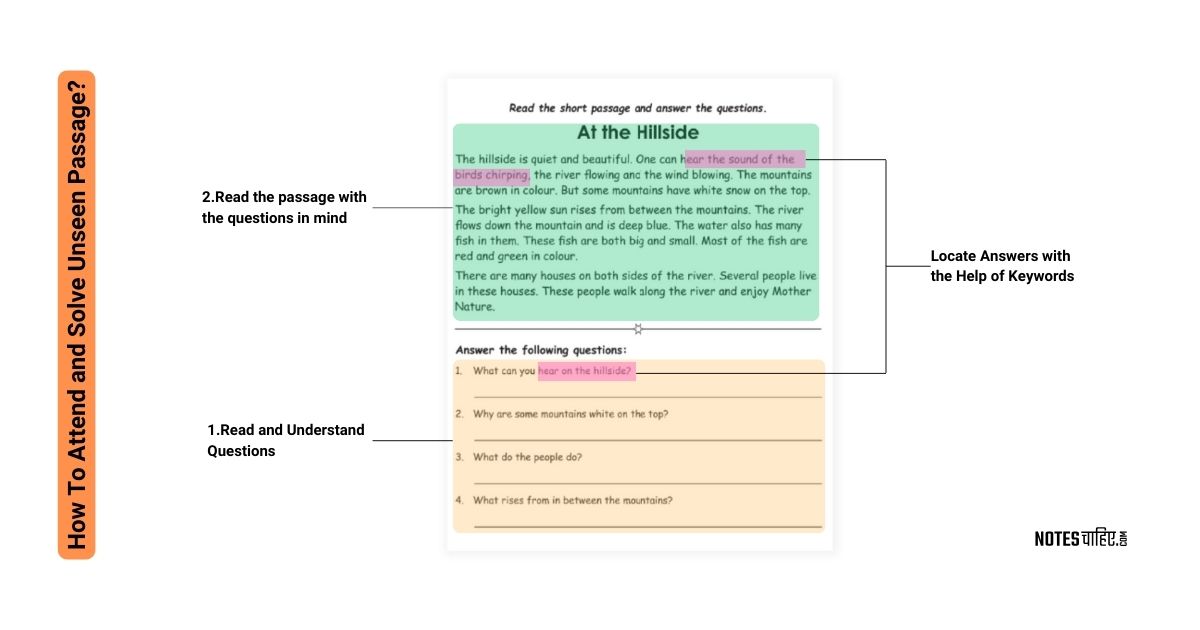
When it come to solve comprehension passage in your English exam, you should follow these steps. Teacher should make student to focus on these 6 steps:
- Read the Questions First
- Understand the Questions
- Read the Passage with the Questions in Mind
- Locate Answers with the Help of Keywords
- Understand the Passage Instead of just Translating
- Answer Should be in the Same Tense, in Which the Question is Given
Best 30 Class 3 Unseen Passage Worksheet with Answer
Here we have provided the different unseen passage worksheet for class 3 students. The passage contains a image, a paragraph, question based on it and answer to practice.
Why best, because we have made categories of the passages on the basis of stories, visits, festivals, manners, health, motivation and morals etc.
It will more helps students for vocabs, reading and writing:
Unseen Passages On Festivals For Class 3
Diwali Delight

In the heart of India, Diwali, the Festival of Lights, brings joy and sparkle to every corner. Families adorn their homes with colorful Rangoli, light oil lamps, and exchange sweets. Amidst the crackling of fireworks, the air is filled with laughter and the warmth of shared moments.
Questions:
- What is Diwali?
- How do families decorate their homes during Diwali?
- What fills the air during Diwali?
- Name one traditional Diwali sweet.
- Why is Diwali called the Festival of Lights?
Answers:
- Diwali is the Festival of Lights celebrated in the heart of India.
- Families decorate their homes with colorful Rangoli and light oil lamps during Diwali.
- The air is filled with laughter and the warmth of shared moments during Diwali.
- One traditional Diwali sweet is exchanged among families.
- Diwali is called the Festival of Lights because of the vibrant illumination that takes place.
Holi Harmony

Holi, the Festival of Colors, sweeps across India with a riot of hues. Friends and family engage in playful color battles, and the air is filled with the joyous shouts of “Holi Hai!” Amidst the vibrant chaos, hearts connect, and differences dissolve in a celebration of unity.
Questions:
- What is Holi?
- How do people celebrate Holi?
- What is shouted during the celebration of Holi?
- What happens amidst the vibrant chaos of Holi?
- What is the theme of Holi?
Answers:
- Holi is the Festival of Colors celebrated in India.
- People celebrate Holi by engaging in playful color battles with friends and family.
- “Holi Hai!” is shouted during the celebration of Holi.
- Amidst the vibrant chaos of Holi, hearts connect, and differences dissolve.
- The theme of Holi is a celebration of unity through colors.
Eid Elegance

Eid, a significant festival for Muslims, is marked by prayers, feasts, and the exchange of gifts. Families come together to share delicious dishes, and the air is filled with the aroma of biryani and sweets. Through acts of kindness and generosity, the essence of Eid radiates the spirit of unity and compassion.
Questions:
- What is Eid?
- How is Eid celebrated by Muslims?
- What do families do during Eid?
- What delicious dishes are mentioned in the passage?
- What does the essence of Eid radiate?
Answers:
- Eid is a significant festival celebrated by Muslims.
- Eid is celebrated with prayers, feasts, and the exchange of gifts by Muslims.
- Families come together to share delicious dishes during Eid.
- Biryani and sweets are mentioned as delicious dishes during Eid.
- The essence of Eid radiates the spirit of unity and compassion through acts of kindness and generosity.
Ganesh Chaturthi Grace
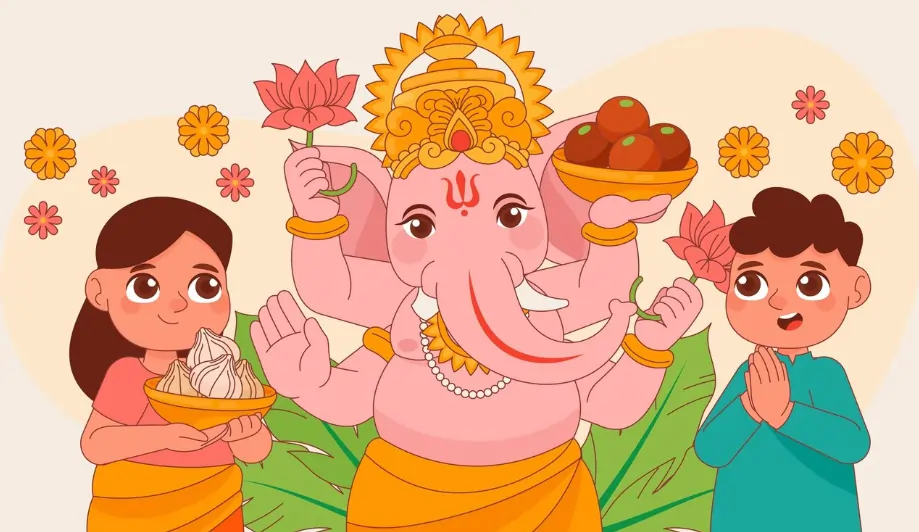
Ganesh Chaturthi, a Hindu festival celebrating Lord Ganesha’s birth, is marked by grand processions and the installation of clay idols. Devotees immerse the idols in water, symbolizing the Lord’s return to his celestial abode. The air resonates with devotional music, and the streets echo with the chants of “Ganpati Bappa Morya.”
Questions:
- What is Ganesh Chaturthi?
- How is Ganesh Chaturthi celebrated?
- What is done with the clay idols during the festival?
- What resonates in the air during Ganesh Chaturthi?
- What is chanted during the processions of Ganesh Chaturthi?
Answers:
- Ganesh Chaturthi is a Hindu festival celebrating Lord Ganesha’s birth.
- Ganesh Chaturthi is celebrated with grand processions and the installation of clay idols.
- Devotees immerse the clay idols in water during the festival.
- Devotional music resonates in the air during Ganesh Chaturthi.
- “Ganpati Bappa Morya” is chanted during the processions of Ganesh Chaturthi.
Unseen Passage On Visits For Class 3
A Visit to the Zoo
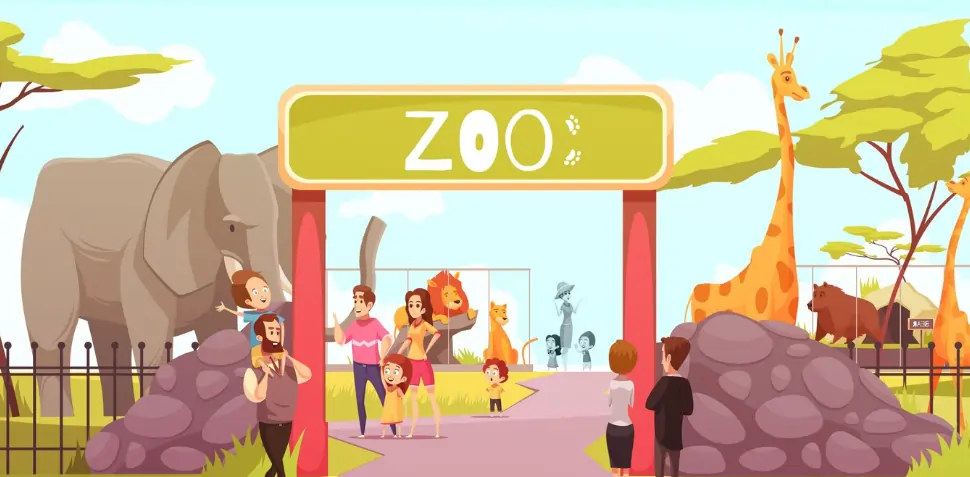
Excitement filled the air as the class of third graders embarked on a field trip to the zoo. The children marveled at the diverse array of animals – from roaring lions to playful monkeys. Wide-eyed and eager, they listened to the guide’s fascinating tales about each creature, learning about habitats and conservation. The day ended with happy faces, new knowledge, and a promise to cherish our furry and feathery friends.
Questions:
- Where did the class of third graders go on a field trip?
- What did the children see at the zoo?
- What did the guide share with the children?
- What did the children learn about during the field trip?
- How did the day end for the third graders?
Answers:
- The class of third graders went on a field trip to the zoo.
- The children saw a diverse array of animals, including lions and monkeys.
- The guide shared fascinating tales about each creature with the children.
- The children learned about habitats and conservation during the field trip.
- The day ended with happy faces, new knowledge, and a promise to cherish the animals.
A Trip to the Science Museum

The third-grade class buzzed with excitement as they explored the wonders of the science museum. Interactive exhibits and hands-on experiments captivated their curious minds. From understanding the solar system to marveling at the laws of physics, the visit ignited a passion for learning and left the students eager to unravel the mysteries of the world.
Questions:
- Where did the third-grade class go for a trip?
- What captivated the students’ curious minds at the science museum?
- What did the students learn about at the science museum?
- How did the visit to the science museum impact the students?
- What were the students eager to do after the visit?
Answers:
- The third-grade class went on a trip to the science museum.
- Interactive exhibits and hands-on experiments captivated the students’ curious minds.
- The students learned about the solar system and the laws of physics at the science museum.
- The visit ignited a passion for learning among the students.
- The students were eager to unravel the mysteries of the world after the visit.
A Journey to the Botanical Garden
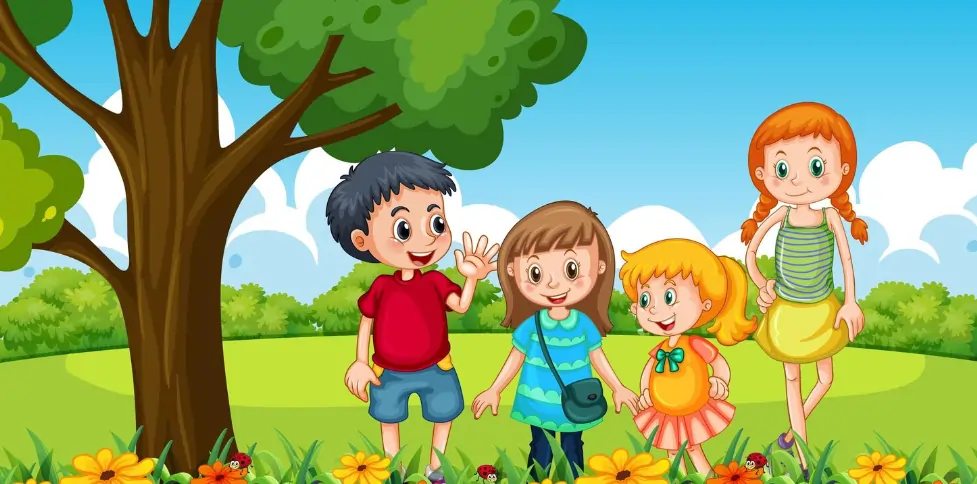
Amidst vibrant blooms and towering trees, the third-grade class embarked on a journey to the botanical garden. The air was filled with the sweet fragrance of flowers as the children explored the diverse plant life. The knowledgeable guide explained the importance of plants, and the children left with a newfound appreciation for nature’s beauty and the vital role plants play in our lives.
Questions:
- Where did the third-grade class go on a journey?
- What filled the air at the botanical garden?
- What did the children explore at the botanical garden?
- What did the knowledgeable guide explain to the children?
- What appreciation did the children gain after the journey?
Answers:
- The third-grade class went on a journey to the botanical garden.
- The air was filled with the sweet fragrance of flowers at the botanical garden.
- The children explored the diverse plant life at the botanical garden.
- The knowledgeable guide explained the importance of plants to the children.
- The children gained a newfound appreciation for nature’s beauty and the vital role plants play in our lives.
Unseen Passages On Great Personalities For Class 3
Mahatma Gandhi – Father of the Nation
Mahatma Gandhi, born in 1869, led India to independence through nonviolent civil disobedience. His teachings of truth, nonviolence, and self-discipline inspired millions. Wearing simple attire, he walked the path of peace, emphasizing the power of love over hatred. Gandhi’s legacy lives on as a symbol of India’s fight for freedom and a reminder that change can be achieved through moral strength.
Questions:
- When was Mahatma Gandhi born?
- How did Gandhi lead India to independence?
- What were Gandhi’s key teachings?
- What attire did Gandhi wear?
- What is Gandhi’s legacy?
Answers:
- Mahatma Gandhi was born in 1869.
- Gandhi led India to independence through nonviolent civil disobedience.
- Gandhi’s key teachings were truth, nonviolence, and self-discipline.
- Gandhi wore simple attire.
- Gandhi’s legacy is a symbol of India’s fight for freedom and a reminder that change can be achieved through moral strength.
APJ Abdul Kalam – Missile Man of India
Dr. APJ Abdul Kalam, born in 1931, served as the 11th President of India. Known as the “Missile Man,” he played a pivotal role in India’s space and missile development. Despite his achievements, Kalam remained humble and dedicated to education, inspiring young minds. His vision of a developed India and his belief in the potential of youth continue to motivate generations.
Questions:
- When was APJ Abdul Kalam born?
- What role did Kalam play in India’s development?
- What is Abdul Kalam’s nickname?
- What remained important to Kalam despite his achievements?
- What is Kalam’s vision for India?
Answers:
- APJ Abdul Kalam was born in 1931.
- Kalam played a pivotal role in India’s space and missile development.
- Abdul Kalam is known as the “Missile Man.”
- Education remained important to Kalam despite his achievements.
- Kalam’s vision for India was of a developed nation, and he believed in the potential of youth.
Narendra Modi – Visionary Leader
Narendra Modi, born in 1950, is the 14th and current Prime Minister of India. With a vision for economic growth and development, Modi initiated various reforms. His leadership style emphasizes bold decisions and inclusivity. Modi’s initiatives, such as ‘Make in India’ and ‘Swachh Bharat Abhiyan,’ reflect his commitment to a prosperous and clean India.
Questions:
- When was Narendra Modi born?
- What is Narendra Modi’s role in Indian politics?
- What is Modi’s vision for India’s development?
- Name one of Modi’s initiatives mentioned in the passage.
- What is Modi’s leadership style?
Answers:
- Narendra Modi was born in 1950.
- Narendra Modi is the 14th and current Prime Minister of India.
- Modi envisions economic growth and development for India.
- One of Modi’s initiatives mentioned in the passage is ‘Swachh Bharat Abhiyan.’
- Modi’s leadership style emphasizes bold decisions and inclusivity.
Bhagat Singh – Revolutionary Martyr
Bhagat Singh, born in 1907, was a revolutionary freedom fighter who sacrificed his life for India’s independence. At a young age, he joined the fight against British rule, advocating for equality and justice. Singh’s bravery, especially in the face of martyrdom, left an indelible mark on India’s history, inspiring future generations to stand up for their beliefs.
Questions:
- When was Bhagat Singh born?
- What did Bhagat Singh fight against?
- What values did Singh advocate for?
- What is Singh’s legacy?
- How did Singh contribute to India’s independence?
Answers:
- Bhagat Singh was born in 1907.
- Bhagat Singh fought against British rule in India.
- Singh advocated for equality and justice.
- Singh’s legacy is marked by his bravery, especially in the face of martyrdom.
- Singh contributed to India’s independence through his revolutionary actions against British rule.
Swami Vivekananda – Spiritual Leader
Swami Vivekananda, born in 1863, was a spiritual leader and key figure in introducing Indian philosophies to the Western world. His famous speech at the World’s Parliament of Religions in 1893 showcased the richness of Hinduism and promoted interfaith harmony. Vivekananda’s teachings on self-realization and service continue to inspire individuals globally.
Questions:
- When was Swami Vivekananda born?
- What role did Vivekananda play in introducing Indian philosophies?
- Where did Vivekananda deliver his famous speech in 1893?
- What did Vivekananda’s speech promote?
- What teachings of Vivekananda continue to inspire individuals?
Answers:
- Swami Vivekananda was born in 1863.
- Vivekananda played a key role in introducing Indian philosophies to the Western world.
- Vivekananda delivered his famous speech at the World’s Parliament of Religions in 1893.
- Vivekananda’s speech promoted the richness of Hinduism and interfaith harmony.
- Vivekananda’s teachings on self-realization and service continue to inspire individuals globally.
Unseen Passages On Morals and Values For Class 3
The Lost Wallet
One sunny day, as Maya and her friends played in the park, they stumbled upon a wallet lying on a bench. Curious, Maya opened it to find money, identification, and a phone number. Despite the temptation, Maya decided to do the right thing. She called the number, and soon, the relieved owner appeared. Maya’s act of honesty not only made her feel proud but also taught her friends the importance of doing what is morally right, even when no one is watching.
Questions:
- What did Maya find in the park?
- What did Maya discover inside the wallet?
- How did Maya feel about finding the wallet?
- What did Maya decide to do despite temptation?
- What did Maya’s act of honesty teach her friends?
Answers:
- Maya found a wallet in the park.
- Maya discovered money, identification, and a phone number inside the wallet.
- Maya felt curious about the wallet.
- Despite temptation, Maya decided to do the right thing.
- Maya’s act of honesty taught her friends the importance of doing what is morally right, even when no one is watching.
The Golden Rule
In Mrs. Patel’s class, a simple yet powerful rule guided the students: treat others as you want to be treated. The students embraced kindness, empathy, and respect, creating a harmonious atmosphere. One day, when a new student joined, the class welcomed them with open arms, showcasing the true impact of following the golden rule.
Questions:
- What guided the students in Mrs. Patel’s class?
- What values did the students embrace?
- How did the students create a harmonious atmosphere?
- How did the class treat the new student?
- What did the class showcase by welcoming the new student?
Answers:
- The students in Mrs. Patel’s class were guided by the golden rule: treat others as you want to be treated.
- The students embraced kindness, empathy, and respect.
- The students created a harmonious atmosphere by following the golden rule.
- The class welcomed the new student with open arms.
- The class showcased the true impact of following the golden rule by welcoming the new student.
The Honest Mistake
During a class quiz, Arjun noticed that he had an extra sheet of notes he didn’t realize he had. While tempted to use it, Arjun chose honesty. He informed the teacher about the mistake. The teacher appreciated Arjun’s integrity, emphasizing that even small acts of honesty build a strong foundation of character.
Questions:
- What did Arjun notice during the class quiz?
- What was on the extra sheet of notes?
- What was Arjun tempted to do?
- What did Arjun choose to do despite temptation?
- How did the teacher respond to Arjun’s honesty?
Answers:
- Arjun noticed that he had an extra sheet of notes during the class quiz.
- The extra sheet of notes contained information Arjun didn’t realize he had.
- Arjun was tempted to use the extra sheet of notes.
- Despite temptation, Arjun chose honesty.
- The teacher appreciated Arjun’s integrity, emphasizing that even small acts of honesty build a strong foundation of character.
Unseen Passage Worksheets On Learning Class 3
The Journey of Learning
Learning is a lifelong journey, akin to exploring uncharted territories. With each lesson absorbed and every challenge embraced, individuals embark on a path of personal growth and knowledge enrichment. The classroom, the library, and the world itself become classrooms, offering valuable insights and experiences that shape one’s understanding of the vast landscape of information.
Questions:
- What is learning compared to in the passage?
- How is learning described as a journey?
- What happens with each lesson absorbed and challenge embraced?
- Besides the classroom, what else becomes a classroom in the journey of learning?
- What does learning contribute to personal growth?
Answers:
- Learning is compared to exploring uncharted territories in the passage.
- Learning is described as a lifelong journey.
- With each lesson absorbed and every challenge embraced, individuals experience personal growth and knowledge enrichment.
- Besides the classroom, the library, and the world itself become classrooms in the journey of learning.
- Learning contributes to personal growth and knowledge enrichment in the journey of exploring uncharted territories.
The Power of Curiosity
At the heart of learning lies the power of curiosity. Like a spark that ignites a flame, curiosity fuels the desire to understand, question, and explore. It propels individuals to seek knowledge beyond the surface, unlocking a world of possibilities. Nurturing curiosity transforms the process of learning into a dynamic and engaging adventure.
Questions:
- What is at the heart of learning in the passage?
- How is curiosity described in the passage?
- What does curiosity fuel the desire to do?
- What does curiosity unlock?
- How is the process of learning transformed by nurturing curiosity?
Answers:
- The power of curiosity is at the heart of learning in the passage.
- Curiosity is described as a spark that ignites a flame.
- Curiosity fuels the desire to understand, question, and explore.
- Curiosity unlocks a world of possibilities.
- Nurturing curiosity transforms the process of learning into a dynamic and engaging adventure.
The Role of Mistakes in Learning
Mistakes are not roadblocks but stepping stones in the journey of learning. Each error, each stumble, offers a valuable lesson. It is through the process of making mistakes that individuals refine their understanding, gaining resilience and a deeper insight into the subject matter. Embracing mistakes is an integral part of the continuous learning process.
Questions:
- How are mistakes described in the passage?
- What do mistakes offer in the journey of learning?
- How do individuals refine their understanding through mistakes?
- What do individuals gain by embracing mistakes?
- Why are mistakes considered an integral part of the learning process?
Answers:
- Mistakes are described as stepping stones in the journey of learning in the passage.
- Each error, each stumble, offers a valuable lesson in the journey of learning.
- Individuals refine their understanding through the process of making mistakes.
- By embracing mistakes, individuals gain resilience and a deeper insight into the subject matter.
- Mistakes are considered an integral part of the continuous learning process.
Unseen Passages On Science For Class 3
The Magic of Science
Once upon a time in the town of Curiousville, there were three friends—Aarav, Maya, and Rohan. They loved exploring the wonders of science. One day, their teacher, Mrs. Sharma, introduced them to the magic of the scientific method.
In their first experiment, the friends planted seeds and watched them grow. They observed how sunlight, water, and care played important roles in the plants’ development. Aarav, Maya, and Rohan were amazed at the power of science to explain the mysteries of nature.
From that day on, the trio eagerly embraced every science lesson. They learned about the planets, the stars, and the incredible diversity of living creatures. Every discovery felt like unlocking a secret code, and the joy of learning science became a lifelong adventure for Aarav, Maya, and Rohan.
Questions:
- Who are the three friends in the story?
- What did the friends love exploring?
- What did they learn in their first experiment?
- Name three things that played important roles in the plants’ development.
- What did the friends find amazing about science?
Answers:
- The three friends in the story are Aarav, Maya, and Rohan.
- The friends loved exploring the wonders of science.
- In their first experiment, they planted seeds and watched them grow.
- Sunlight, water, and care played important roles in the plants’ development.
- The friends found it amazing that science could explain the mysteries of nature.
The Marvels of Magnets
In the town of Wonderburg, there lived a young scientist named Riya. Riya was fascinated by magnets and their magical powers. With a magnetic wand, she discovered that magnets could attract certain objects like paperclips and repel others.
Curious to learn more, Riya conducted experiments with different types of magnets. She found that magnets had two poles, North and South, and they always attracted the opposite poles while repelling similar ones. Riya’s excitement grew as she realized the marvels of magnets and their invisible forces.
Armed with this newfound knowledge, Riya shared her discoveries with her classmates, turning every science lesson into a magnetic adventure.
Questions:
- Who lived in the town of Wonderburg?
- What fascinated Riya?
- What objects could magnets attract, according to Riya’s experiments?
- How many poles do magnets have?
- How did Riya share her discoveries with her classmates?
Answers:
- Riya, the young scientist, lived in the town of Wonderburg.
- Magnets and their magical powers fascinated Riya.
- According to Riya’s experiments, magnets could attract objects like paperclips.
- Magnets have two poles, North and South.
- Riya shared her discoveries with her classmates, turning every science lesson into a magnetic adventure.
The Dance of Colors – Rainbows
One rainy day in the village of Spectrumville, four friends—Kavi, Anaya, Rohit, and Maya—discovered the magical dance of colors in the sky. As the rain stopped and the sun peeked through the clouds, a beautiful rainbow appeared.
Excited, the friends learned that rainbows were formed when sunlight interacted with raindrops in the air. Each color in the rainbow represented a different wavelength of light. They remembered the order of colors with the acronym ROYGBIV—Red, Orange, Yellow, Green, Blue, Indigo, and Violet.
From that day forward, Kavi, Anaya, Rohit, and Maya looked forward to rainy days, hoping to witness the enchanting dance of colors in the sky.
Questions:
- Where did the friends discover the magical dance of colors?
- What appeared in the sky after the rain stopped?
- How are rainbows formed?
- What does each color in the rainbow represent?
- How did the friends remember the order of colors in the rainbow?
Answers:
- The friends discovered the magical dance of colors in the village of Spectrumville.
- After the rain stopped, a beautiful rainbow appeared in the sky.
- Rainbows are formed when sunlight interacts with raindrops in the air.
- Each color in the rainbow represents a different wavelength of light.
- The friends remembered the order of colors in the rainbow with the acronym ROYGBIV—Red, Orange, Yellow, Green, Blue, Indigo, and Violet.
Unseen Passages On Savings and Money For Class 3
The Savings Adventure
In the bustling town of Thriftville, lived a young boy named Aryan who embarked on a savings adventure. Aryan received a piggy bank as a gift and decided to start saving his pocket money. Every week, he carefully placed a portion of his money into the piggy bank, watching it grow.
As Aryan saved, he learned about the importance of money. His parents explained that saving money could help him achieve his dreams, whether it was buying a toy or planning for the future. Aryan felt a sense of accomplishment as he witnessed the power of small savings turning into something significant.
One day, Aryan opened his piggy bank to count his savings. To his delight, he had enough to buy the toy he had been eyeing. The adventure of saving not only taught Aryan about money but also instilled a valuable lesson about patience and goal-setting.
Questions:
- What did Aryan receive as a gift?
- What did Aryan decide to start doing with his pocket money?
- What did Aryan learn about the importance of money?
- What sense of accomplishment did Aryan feel?
- What lesson did Aryan learn through the savings adventure?
Answers:
- Aryan received a piggy bank as a gift.
- Aryan decided to start saving his pocket money.
- Aryan learned that saving money could help him achieve his dreams.
- Aryan felt a sense of accomplishment as he saw his savings grow.
- Through the savings adventure, Aryan learned about money, patience, and goal-setting.
The Wise Owl’s Money Tips
In the village of Prosperity Grove, an old and wise owl named Guru provided valuable money tips to the young ones. Guru emphasized the importance of budgeting—keeping track of income and expenses. He explained that budgeting helped individuals prioritize their spending and save for the future.
Guru also spoke about the magic of compounding. He shared how saving money in a bank allowed it to grow over time, thanks to the interest earned. The wise owl encouraged the villagers to be mindful of their expenses, avoid unnecessary debt, and invest wisely.
The young villagers, inspired by Guru’s advice, started practicing good money habits. As they followed his tips, the village flourished, and everyone learned the art of managing money wisely.
Questions:
- Who provided money tips in Prosperity Grove?
- What did Guru emphasize the importance of?
- How does budgeting help individuals?
- What did Guru say about the magic of compounding?
- What were the results of the young villagers following Guru’s advice?
Answers:
- Guru, the old and wise owl, provided money tips in Prosperity Grove.
- Guru emphasized the importance of budgeting.
- Budgeting helps individuals prioritize their spending and save for the future.
- Guru explained that saving money in a bank allows it to grow over time due to the interest earned.
- The village flourished as the young villagers followed Guru’s advice, learning the art of managing money wisely.
The Tale of Two Jars
In the town of Wisdom Wells, two friends, Aisha and Rohan, each had a jar to save money. Aisha’s jar was labeled “Spending,” and Rohan’s jar was labeled “Saving.” Every time they received money, Aisha would put it in her spending jar and buy small treats. On the other hand, Rohan diligently saved his money in the saving jar for something special.
Over time, Aisha realized that her treats were enjoyable, but the joy was short-lived. Rohan, however, had saved enough money to buy a bicycle. Aisha learned the importance of balancing spending and saving wisely.
The tale of two jars in Wisdom Wells taught everyone that while enjoying small treats is delightful, saving for meaningful goals brings long-lasting happiness.
Questions:
- What did Aisha and Rohan each have in the town of Wisdom Wells?
- How did Aisha use her money?
- What did Rohan do with his money?
- What did Aisha realize over time?
- What lesson did everyone learn from the tale of two jars?
Answers:
- Aisha and Rohan each had a jar in the town of Wisdom Wells.
- Aisha put her money in her spending jar and bought small treats.
- Rohan diligently saved his money in the saving jar.
- Aisha realized that while treats were enjoyable, the joy was short-lived.
- Everyone learned that while enjoying small treats is delightful, saving for meaningful goals brings long-lasting happiness.
The Money Tree
In the enchanting forest of Prospera, there stood a magical money tree. This tree had golden leaves that turned into coins when they fell. The wise animals of the forest understood the importance of using the money wisely.
Sara, a young squirrel, discovered the money tree one day. Instead of hoarding the coins, she decided to plant some back into the soil. As the seasons passed, more money trees sprouted, creating a grove of abundance.
The animals of Prospera, inspired by Sara’s wisdom, used the coins to invest in education, health, and community projects. The magical money tree not only provided financial abundance but also taught the forest inhabitants the significance of responsible money management.
Questions:
- Where did the magical money tree stand?
- What happened when the golden leaves of the tree fell?
- What did Sara decide to do with the coins?
- What grew as a result of Sara’s decision?
- What did the animals of Prospera learn from the magical money tree?
Answers:
- The magical money tree stood in the enchanting forest of Prospera.
- When the golden leaves fell, they turned into coins.
- Sara decided to plant some coins back into the soil.
- As a result of Sara’s decision, more money trees sprouted, creating a grove of abundance.
- The animals of Prospera learned the significance of responsible money management from the magical money tree.
The Treasure Hunt
In the coastal village of Discovery Bay, a group of friends organized a treasure hunt. Each participant was given a map, and the goal was to find the hidden treasure chest. As the friends navigated through clues and challenges, they realized that managing money could be like a treasure hunt.
The journey to financial success, they discovered, involved setting goals, making wise choices, and overcoming obstacles. The friends learned the importance of saving and investing to build their financial treasure. The treasure hunt in Discovery Bay became a valuable lesson in financial literacy for all participants.
Questions:
- Where did the group of friends organize a treasure hunt?
- What was the goal of the treasure hunt?
- What did the friends realize about managing money during the hunt?
- What did the journey to financial success involve?
- What did the treasure hunt become for all participants?
Answers:
- The group of friends organized a treasure hunt in the coastal village of Discovery Bay.
- The goal of the treasure hunt was to find the hidden treasure chest.
- During the hunt, the friends realized that managing money could be like a treasure hunt.
- The journey to financial success involved setting goals, making wise choices, and overcoming obstacles
Unseen Passages On Father, Mother, and Teacher For Class 3
The Guiding Light – Father
In the heart of Loveville, there lived a remarkable man named Mr. Sharma, a loving father to two children. He was like a guiding light, providing support and wisdom. Every evening, Mr. Sharma shared stories with his children, teaching them valuable life lessons. His laughter echoed through the house, creating a warm and nurturing environment. To his children, Mr. Sharma was not just a father; he was their hero and the pillar of strength in Loveville.
Questions:
- What is the name of the remarkable man in Loveville?
- How does Mr. Sharma provide support and wisdom?
- What does Mr. Sharma share with his children every evening?
- What kind of environment does Mr. Sharma create in the house?
- What is Mr. Sharma to his children in Loveville?
Answers:
- The remarkable man in Loveville is named Mr. Sharma.
- Mr. Sharma provides support and wisdom like a guiding light.
- Every evening, Mr. Sharma shares stories with his children.
- Mr. Sharma creates a warm and nurturing environment in the house.
- Mr. Sharma is not just a father; he is their hero and the pillar of strength to his children in Loveville.
The Heart of the Home – Mother
In the cozy town of Harmony Hills, Mrs. Kapoor was the heart of her home. As a mother, she wore many hats – chef, teacher, and comforter. Mrs. Kapoor’s kitchen was a place filled with the aroma of love and homemade delights. She guided her children through the maze of life, offering both advice and a listening ear. In Harmony Hills, Mrs. Kapoor wasn’t just a mother; she was the embodiment of love and the anchor that held her family together.
Questions:
- Who is the heart of the home in Harmony Hills?
- What roles does Mrs. Kapoor play as a mother?
- How would you describe Mrs. Kapoor’s kitchen?
- What does Mrs. Kapoor offer to her children in the maze of life?
- What is Mrs. Kapoor to her family in Harmony Hills?
Answers:
- Mrs. Kapoor is the heart of the home in Harmony Hills.
- Mrs. Kapoor plays the roles of a chef, teacher, and comforter as a mother.
- Mrs. Kapoor’s kitchen is described as a place filled with the aroma of love and homemade delights.
- In the maze of life, Mrs. Kapoor offers both advice and a listening ear to her children.
- Mrs. Kapoor is not just a mother; she is the embodiment of love and the anchor that holds her family together in Harmony Hills.
The Torchbearer – Teacher
In the educational hub of Wisdomville, Mrs. Gupta was a dedicated teacher, lighting the path of knowledge for her students. With passion and enthusiasm, she made every lesson a journey of discovery. Mrs. Gupta not only imparted academic wisdom but also instilled values of kindness and curiosity. In Wisdomville, she was more than a teacher; she was a torchbearer, guiding her students towards a brighter future.
Questions:
- Who is the dedicated teacher in Wisdomville?
- How does Mrs. Gupta light the path of knowledge for her students?
- What does Mrs. Gupta impart in addition to academic wisdom?
- How would you describe Mrs. Gupta’s lessons?
- What is Mrs. Gupta to her students in Wisdomville?
Answers:
- Mrs. Gupta is the dedicated teacher in Wisdomville.
- Mrs. Gupta lights the path of knowledge for her students with passion and enthusiasm.
- Mrs. Gupta imparts values of kindness and curiosity in addition to academic wisdom.
- Mrs. Gupta’s lessons are described as a journey of discovery.
- Mrs. Gupta is more than a teacher; she is a torchbearer, guiding her students towards a brighter future in Wisdomville.
The Bonds of Friendship
In the vibrant village of Joyville, four friends—Rahul, Priya, Aryan, and Maya—shared an unbreakable bond of friendship. They laughed together, supported each other, and faced challenges as a team. In Joyville, their friendship wasn’t just a connection; it was a tapestry woven with shared memories and the joy of companionship. Through thick and thin, Rahul, Priya, Aryan, and Maya cherished the beauty of their bonds in the heartwarming village of Joyville.
Questions:
- Who are the four friends in Joyville?
- What kind of bond do Rahul, Priya, Aryan, and Maya share?
- How do the friends face challenges?
- What is their friendship described as in Joyville?
- What do the friends cherish through thick and thin?
Answers:
- The four friends in Joyville are Rahul, Priya, Aryan, and Maya.
- Rahul, Priya, Aryan, and Maya share an unbreakable bond of friendship.
- The friends face challenges as a team.
- Their friendship is described as a tapestry woven with shared memories and the joy of companionship in Joyville.
- Through thick and thin, the friends cherish the beauty of their bonds in the heartwarming village of Joyville.

